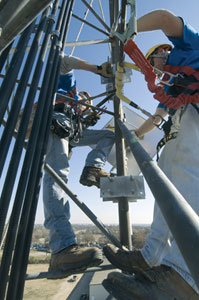 Black & Veatch Wireless networks are poised for more growth. |
As customers demand better access and government regulators require increased reliability, companies in the telecommunications market are dishing out billions of dollars in new projects to contractors.
Data centers remain a hotbed of activity. Since picking up steam two years ago, demand for larger data centers that support higher-density computing continues to soar. Terence Deneny, vice president of Structure Tone Inc.’s mission-critical office in New York City, says the company has seen revenue in the sector increase by more than 30% in the past year.
“The amount of projects under contract and the number of opportunities we’re pursuing today are at historic levels going back to the dot-com days of 1998 and 1999,” he says.
Financial service firms and insurance companies are among the top clients for mission-critical teams at top contracting firms. The need to store and protect larger amounts of data, which is driven largely by compliance requirements under the federal Sarbanes-Oxley Act, means that centers are not only becoming more powerful, but also more plentiful as companies require synchronous data in multiple facilities. Health-care companies are also facing data-center demands related to compliance with the Health Insurance Portability and Accountability Act.
The rapid evolution of blade server technology to increase data capacity and speed is putting tremendous pressure on data-center infrastructure. Deneny notes that while most loads in 2000 were in the 1-kW-per-cabinet range, the average is between 3 kW and 5 kW per cabinet today. He expects that average to nearly double in the coming years.
Skanska USA is seeing a similar trend. Jakob Carnemark, senior vice president of mission critical in Skanska’s New York-New Jersey office, says that data centers built in 2000 were fitted to handle 30 watts to 50 watts per sq ft. Many projects today are demanding 150 watts per sq ft.
As a result, data centers built in the last five to 10 years are struggling to properly cool and power the new generation of servers, forcing companies to expand existing facilities or build new ones. “Existing data centers are simply unable to support these new server densities,” Carnemark says.
Many of these projects require redundancy in cooling and electrical equipment, in case of problems with the primary systems. “If you lose cooling, these things go down quickly,” Carnemark adds.
The push for more power and cooling puts pressure on the long-term costs of data centers. Carnemark says that many clients are expecting to spend as much on maintenance and energy usage on data centers over 10 years as they will on the initial construction costs. “When you’re talking $50 million to $100 million to build these, that’s a huge investment,” he says.
The government is beginning to take notice. The U.S. Environmental Protection Agency released a report in August that highlights the growing power consumption of data centers and the need for greater energy efficiency. EPA reports that data centers used 61 billion kWh of power in 2006, or 1.5% of the total electricity used in the U.S. That is twice the amount consumed in 2000.
Rather than face soaring utility bills and potential government regulations, many companies are now looking at greening their data centers. Deneny says Structure Tone currently has two projects under way that are designed to meet LEED standards.
Microsoft Corp. broke ground on a new $550-million green data center in San Antonio, Texas, in July. The company claims the 500,000-sq-ft facility will include such green elements as recycled water in its cooling systems and power purchased from renewable sources.
Microsoft is among a group of technology companies building billions of dollars worth of data centers in the coming years. In many cases the projects will be green. While financial institutions are required to keep their data centers within close proximity of each other, technology companies are going to where the power is cheaper. Areas of Oregon and Washington state have been the sites of new projects in recent years, including a massive new data center for Google in The Dalles, Ore., near The Dalles Dam hydroelectric facility on the Columbia River.
Rick Morgan, vice president of Atlanta-based Holder Construction Co., says data center expansions by companies like Google are likely to continue into the foreseeable future. “Many of the corporate clients will follow the economy,” he explains. “If the economy is good, they will keep building. But the Internet will remain strong regardless.”
While many contractors are banking on data center projects, work for cell carriers has been a recent source of frustration. Major mergers have put capital programs on hold while consolidation strategies are considered. John McCann, CEO of Conti Communications Inc., Raritan, N.J., says his company struggled in the second half of 2006 in the wake of the merger of AT&T and Cingular Wireless. “All of their cap-ex was put on hold,” he says.
While planned work with major cell carriers has experienced hiccups recently, Travers is confident that the sector will remain strong over the long haul. “The good news is that no customer want less coverage or quality,” he adds. “This is now basic infrastructure that’s an essential part of life. We’re very optimistic about the prognosis for continued growth.”
 Related Links:
Related Links: 
Post a comment to this article
Report Abusive Comment